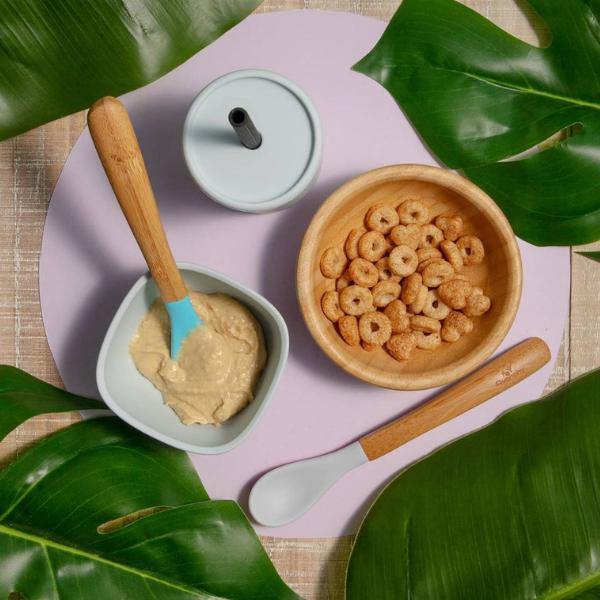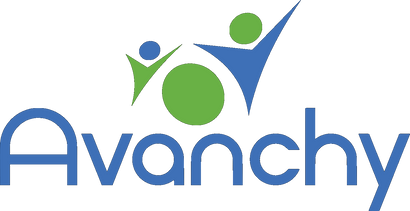BLACK FRIDAY Up to 60% OFF SALE!
BLACK FRIDAY Up to 60% OFF SALE!
Feeding Essentials

Moving To Solid Food!
November 12, 2020 7 min read
When you start to see signs that your baby is ready to eat, you can start training your baby to eat complementary foods. Therefor eating is a skill that he must learn, including learning how to move his mouth to receive food from a spoon. Learning to eat also strengthens your little one's mouth muscles. These muscles are needed to receive larger bites of food later, and also to speak.
The right time to give complementary foods
The time of administration of complementary foods recommended by the AAP (The American Academy of Pediatrics) is between 4 to 6 months. However, the exact answer really depends on the readiness of the child. Here are some signs that your baby is ready to start eating solid foods:
- The child can sit up straight and raise his head.
- Kids are curious to see everything around them, especially your food.
- The child has lost the tongue sticking reflex that can automatically push food out of his mouth.
- Even after breastfeeding regularly, the child still shows signs of hunger, such as restlessness and restlessness.
Here are the 8 best foods for babies who are just learning to eat:
1. Apples
Apples are delicious fruit and much loved by children. You can introduce apples to your little one between the ages of 6 and 8 months. Eating an apple a day is very good for the health of the baby.
One of the most important nutritional components of apples is their fiber content which helps the intestines work. Other nutrients in apples include vitamins A and E, folate, phosphorus, magnesium and selenium. Nutritionists recommend serving applesauce instead of one solid apple, until the baby is 8 months old.
2. Bananas
Just like apples, bananas are also good solids for babies. You can give bananas to your baby after they reach the age of 5 months. Rich in potassium, bananas help control the water balance in the body. Potassium also helps muscle function and is responsible for relaxing the heart muscle and heart rhythm of babies. It even reduces the risk of kidney stones and osteoporosis in the future.
In addition, bananas will meet the needs of carbohydrates which function to provide energy and fiber which smoothes the digestive tract. Here's how to serve bananas for baby food: Use a fork to crush the bananas into a pudding-like shape. Then, serve it to your little one. For older babies, chopped bananas are an excellent side dish.
3. Avocado
One of the best complementary foods for babies is avocado. Moms can introduce avocado into baby food after your little one reaches 4 months of age.
Avocados are rich in monounsaturated fat which helps the baby's brain development. This type of fat also provides a much needed energy boost for babies. Plus, the fiber content is good for digestion. Apart from that, avocado has a light taste and subtle consistency that most babies love.
4. Pear
Pears are a nutritious fruit which is the best complementary food for other babies. The right age to introduce pears to baby food is between 6 and 8 months. This delicious fruit is rich in fiber, copper and vitamin C. Fiber promotes healthy digestion, and doctors often recommend pears as a remedy to help relieve constipation in babies. Vitamin C and copper protect body cells from damage and support the immune system.
Apart from being a good source of vitamins, minerals and antioxidants, pears are suitable for sensitive digestive systems in babies. The method of serving pears does not need to be cooked. When they are ripe, they are very soft and easily turn into a fine pulp.
5. Carrots
Carrots are also one of the complementary foods for babies who are just learning to eat, because they are easy to swallow and digest and even delicious to eat. This root vegetable contains beta-carotene which helps the development of healthy baby's skin, eyesight and immune system.
Carrots are also packed with nutrients including vitamins C, K and B8, along with calcium, folate, potassium, iron, copper and manganese.
6. Sweet Potatoes
Sweet potatoes are one of the best complementary foods for your baby. Most babies like the soft and sweet taste of sweet potatoes. Sweet potatoes are one of the most abundant sources of beta carotene that the body can convert into vitamin A. Vitamin A is essential for good eyesight, skin health and the overall growth and development of a baby.
7. Squash
Another vegetable that is great for babies is squash, especially butternut and acorn squash. In fact, the bland or savory taste of squash makes a healthy alternative to sweet fruit. These foods can be introduced to babies between 6 and 8 months of age.
Squash is a great source of vitamins A and C. Vitamin A is used for vision and skin health, vitamin C is needed to increase the baby's immune system so that your little one can fight infections easily. Other nutrients contained in squash are potassium, calcium, folate, protein, carbohydrates and dietary fiber.
8. Broccoli
Broccoli which is rich in vitamin C, fiber and calcium is a good main food for children. Usually, it should be introduced around 8 to 10 months of age.
Vitamin C boosts the baby's immune system. The calcium in broccoli helps promote good vision and prevents cell damage. The fiber in it keeps the digestive system working properly. Broccoli also has several B vitamins that help improve nervous system function.
Other important nutrients in broccoli are iron, magnesium, phosphorus, potassium, zinc and folic acid. Plus, broccoli's unique taste can help increase your baby's appetite.
Here are tips that you can follow in training your little one to eat.
Avanchy.com1. Introduce Texture Gradually, Starting from Smooth Food
Learning to eat seems like a difficult task, but it's actually more about introducing different textures in stages. First, your little one needs to get used to the sensation of solid food in the mouth. Learn to move food with his tongue from front to back then swallow it. That is why foods that are smooth / mashed are best for little ones who are starting to be given additional food.
2. Switch to Solid FoodsOnce your little one is able to cope with refined or mashed food, the next step is to start learning to chew. For this stage, your little one needs food with a denser texture. In order for the food to be ready to be swallowed, your little one needs to move his jaw slightly up and down.
When your little one becomes interested in denser foods, this is his sign to move to the next step of supplementary feeding, which is learning to chew small pieces of food.3. Introductions to Different Shapes and Textures
Your little one needs variety in order to stay interested in eating, even though he is ready to chew on a more varied form and texture of food, you must ensure that your little one's menu is full of balanced nutrition that is right for him. Let your little one eat alone so that he is more independent and directs him one step closer to eating with family.
4. Slowly Introduce New Flavors
Learning to eat also means introducing new flavors to your little one. At the beginning of supplementary feeding, babies should be accustomed to tastes other than the taste of milk. Generally, your little one is born with a taste for sweet foods. So, naturally the sweet taste is more favorable to him and easier for the little one to accept. Try a variety of vegetables (such as carrots, turnips, potatoes, pumpkin, peas and sweet potatoes) and fruits (such as pears, apples, apricots, bananas and mangoes). Introduce a variety of foods in one taste to start, before moving on to more balanced food combinations. It is important for your little one to learn to recognize all tastes. So, be patient and keep trying to introduce many variations of delicious food to your little one.
5. Find The Best Baby Dishware
When complementary foods start, the child is starting the learning process to recognize hunger, fullness, chewing, and swallowing. Like a learning process, parents should choose equipment that can make it easier for them to go through each stage smoothly and safely. There are hings that must be considered when choosing tableware for babies:
- BPA Free: Bisphenol A or BPA is a chemical used to harden plastic containers. One of the active components of BPA is the hormone estrogen, which when dissolved in water can be a source of various diseases. So, make sure baby utensils are free of BPA.
- Food grade label: Cutlery with a food grade label indicates the cutlery is safe from hazardous chemicals and does not absorb food.
- Make sure it is not sharp: So that the baby does not get hurt when eating and drinking, choose cutlery made of thick and blunt silicone.
After knowing what to pay attention to when choosing baby tableware, let's us introduce you with Avanchy La Petite Family Collections.
Avanchy La Petite Family Collections
La Petite Family collections provides you with Silicone Cup, Silicone Bowl, Bamboo Bowl, and Bamboo Spoons! Perfect gear for your little one to start with food! All Plastic-free, BPA-free, BPS-free, PVC-free, lead-free, and phthalate-free! Here's what you need to know about them:
- When your little one is ready to move to solid foods, Avanchy’s La Petite Silicone Bowl is ready to serve. It may look sweet, but this durable, little silicone bowl stands up to almost anything. Prep in it, feed from it, nuke it, freeze it, and wash it in the dishwasher with no worries. And it holds just the right amount of baby’s favorite first-stage foods. Safe, cute, colorful, designed to fit comfortably in your hand.
Avanchy La Petite Mini Silicone Bowl
- Avanchy's La Petite Mini Cup includes a lid and gentle straw to support baby led weaning. Toddlers learning to drink independently for the first time will enjoy the grown-up cup with the safety of our silicone design.
Avanchy La Petite Mini Silicone Cup
- Avanchy La Petite Mini Bamboo baby feeding bowl is an excellent option for kitchenware that is both safe for your family and will last for years to come. Promote healthy living for your family with this sleek petite bamboo training bowl.
Avanchy La Petite Mini Bamboo Bowl
- Avanchy bamboo infant spoon was crafted with you and your infant in mind. Avanchy Bamboo Infant Spoon has a smaller head and longer handle that's ideal for spoon-feeding your child. The silicone tip is soft and gentle for their tender gums. The lightweight bamboo infant spoon is as colorful as it is practical.
Avanchy Bamboo Infant Spoon
So now, are we ready to teach our babies to eat? Let's do this!
Subscribe
Sign up to get the latest on sales, new releases and more …














